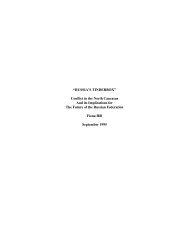Global Environmental Assessment Project - Belfer Center for ...
Global Environmental Assessment Project - Belfer Center for ...
Global Environmental Assessment Project - Belfer Center for ...
You also want an ePaper? Increase the reach of your titles
YUMPU automatically turns print PDFs into web optimized ePapers that Google loves.
It appears that the primary effect of the SSD was to clarify the goals of competing water uses on the<br />
Colorado River, particularly between consumptive and non-consumptive (or instream) uses and between<br />
the Upper and Lower Basins. As highlighted in the summary chapter of the SSD:<br />
"Existing operating rules ... favor consumptive water uses over such non-consumptive<br />
uses as hydroelectric power generation, environmental protection, salinity control, and<br />
recreation. The extent of this favoritism... is out of all proportion to what are, arguably,<br />
the public values involved." (Lord et al., 1995, p. 942).<br />
Three of the eight Advisory Council members interviewed found SSD principal investigators to be<br />
predisposed to protecting instream uses. In one case, an AC member recalled that the study helped him<br />
clarify the agenda of instream water use advocates. Furthermore, recommendations such as creation of a<br />
basin-wide commission and the establishment of interstate water banks had been previously suggested in<br />
other venues with limited positive reception from the basin states. With positions on these issues already<br />
established by groups represented in the AC, the SSD recommendations clarified different agendas - in<br />
the words of one AC member "we went in with stated positions on these issues, and study results weren't<br />
likely to change them".<br />
Timing<br />
The SSD study was published in 1995. Since this time, levels in Lakes Mead and Powell have been near<br />
capacity (Figure 2). 11 Together, these two reservoirs can hold more than three times the annual flow the<br />
of the Colorado River - when they're full, the concern <strong>for</strong> drought tends to be low. Rather than being<br />
focused on long- or short-term drought, the Colorado Basin states are currently preoccupied with<br />
allocating surplus water, driven by increasing demand rather than decreasing supply. Interviews across<br />
the three groups in Table 3 indicate that drought isn't a current concern in the Colorado Basin, let alone<br />
one that lasts nearly 20 years, and that the timing of SSD assessment seems to have prevented it from<br />
having a greater impact.<br />
If a severe-drought crisis had coincided with the publication of the study, the result may have been<br />
significantly different. Indeed, in "closing water systems" such as the Colorado, crisis appears to be<br />
necessary to promote recognition of interdependent uses and negotiation of agreements amongst basin<br />
states (Pulwarty and Melis, 2000). As discussed in the next section, the crisis of declining salmon<br />
populations in the Columbia River Basin has led to the consideration of alternative management<br />
approaches, including recognition of the ocean's role in salmon mortality, and the once-radical idea of<br />
dam removal. Given the lack of a crisis event in the Colorado Basin, it may be premature to evaluate the<br />
effectiveness of the SSD assessment, as its findings and recommendations could yet be used in future<br />
drought scenarios.<br />
Although the timing of SSD publication coincided with abundant water supply in the Colorado Basin,<br />
much of the West was in the grip of drought during the Advisory Council meetings in 1991 and 1992.<br />
During this time, water levels in Lake Powell were at their lowest since the initial filling of the reservoir<br />
and storage in Lake Mead dropped by nearly 4 million acre-feet compared to the wet years of the mid-<br />
1980's (Figure 2). Both Arizona and Cali<strong>for</strong>nia, <strong>for</strong> example, faced limits to surplus water from the<br />
Colorado River, and strict conservation programs were enacted in southern Cali<strong>for</strong>nia and Las Vegas<br />
(Fradkin, 1995). Thus, discussion of long-term drought was quite timely, as the impacts of drought were<br />
occurring in the states represented by AC members. If timing was a primary determinant of the<br />
8
















